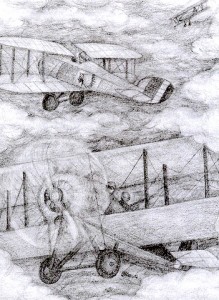|
J. William T. "Bill" Youngs, American Realities, Volume Two:
Historical Episodes from Reconstruction to the Present, Chapter Seven |
"The Lafayette Escadrille" courtesy of the National Museum of the US Air Force
|
7. World War I
|
SummaryThis essay tells the story of a particular group of Americans, volunteers who fought for France in the air before the United States entered World War I. The article describes also the dawn of a new technology, aviation, describing how one became a pilot and what it was like to be among the first human beings to leave the ground and “imitate the birds.” The essay describes the brutality of the war, both high above the ground in aerial combat and on the ground in trench warfare. Finally, the story of the Lafayette Escadrille reveals the idealism of young Americans fighting for France-an idealism that the nation as a whole would eventually embrace.
|
Author reads from the Text
Many of the American volunteers in the French Flying Corps were the sons of wealthy families and graduates of prestigious colleges, but at the training camps not all the men fit that description. As one volunteer noted: “There is a fine crew in this school, men from all colleges and men who don’t know the name of a college, . . . men sticky with money in the same barracks with others who worked their way over on ships.” He went on to describe an African American in the barracks—most likely Edward Bullard of Columbus, Georgia. At the time the American army was segregated, but that was not the case with the French forces. Although the American pilot described his African American compatriot in terms that today would be considered racial stereotypes, he still demonstrated a healthy respect for his fellow pilot:
“This democracy is a fine thing in the army and makes better men of all hands. For instance, the corporal of our room is an American, as black as the ace of spades, but a mighty white fellow at that. The next two bunks to his are occupied by Princeton men of old Southern families. They talk more like a darky than he does and are the best of friends with him. . . . This black brother has been in the Foreign Legion, wounded four times, covered with medals for his bravery in the trenches, and now uses his experiences and knowledge of French for the benefit of our room.”
“This democracy is a fine thing in the army and makes better men of all hands. For instance, the corporal of our room is an American, as black as the ace of spades, but a mighty white fellow at that. The next two bunks to his are occupied by Princeton men of old Southern families. They talk more like a darky than he does and are the best of friends with him. . . . This black brother has been in the Foreign Legion, wounded four times, covered with medals for his bravery in the trenches, and now uses his experiences and knowledge of French for the benefit of our room.”

